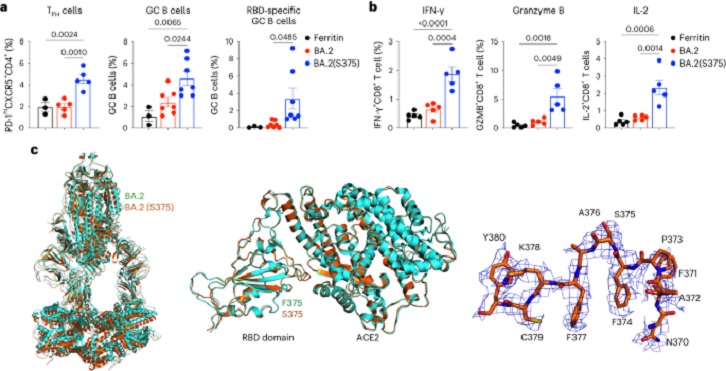RBD Of SARS-CoV-2 Omicron Sub-Lineages Targets Siglec-9 To Decrease Its Immunogenicity By Preventing Macrophage Phagocytosis
Nikhil Prasad Fact checked by:Thailand Medical News Team Mar 11, 2024 1 year, 9 months, 3 weeks, 23 hours, 54 minutes ago
COVID-19 News: The quest for an effective vaccine against severe acute respiratory syndrome coronavirus 2 (SARS-CoV-2) Omicron variant has encountered challenges, primarily stemming from its lower immunogenicity compared to the Delta strain.
 RBD Of SARS-CoV-2 Omicron Sub-Lineages Targets Siglec-9 To Decrease Its Immunogenicity By Preventing Macrophage Phagocytosis
RBD Of SARS-CoV-2 Omicron Sub-Lineages Targets Siglec-9 To Decrease Its Immunogenicity By Preventing Macrophage Phagocytosis
Researchers at Zhongshan School of Medicine, Sun Yat-sen University, Guangzhou, China, undertook a groundbreaking study that is covered in this
COVID-19 News report, utilizing reverse mutagenesis to unravel the complexities of Omicron subvariants and devise strategies to enhance vaccine efficacy.
A pivotal finding emerged through the identification of a specific mutation in the Omicron spike protein at position 375 (F375S). This phenylalanine-to-serine mutation, inspired by the sequence found in the Delta and other ancestral strains, remarkably amplified the immunogenicity of Omicron vaccines. The F375S mutation proved to be a key determinant in bolstering the immune response, opening new avenues for vaccine development against the Omicron variant.
Macrophage Phagocytosis Inhibition
Further exploration revealed the emergence of a distinctive sequence, 371FAPF375FAF, in the Omicron spike. Intriguingly, this sequence exhibited a potent inhibitory effect on macrophage uptake of receptor-binding domain (RBD) nanoparticles or spike-pseudovirus particles containing the identified sequence. The inhibitory impact on macrophage phagocytosis presented a novel challenge to vaccine development, shedding light on the intricate interactions between the Omicron spike and immune cells.
Siglec-9 and Immune Evasion
Omicron's receptor binding domain (RBD) demonstrated an enhanced binding affinity to Siglec-9 on macrophages. This interaction impaired phagocytosis and antigen presentation, leading to a reduction in immunogenicity and promoting immune evasion. The significance of Siglec-9 in the immune response to Omicron unveiled a potential target for intervention to overcome the immunogenic challenges posed by this variant.
Restoring Immunogenicity with F375S Mutation
The adverse effects on macrophage functions and subsequent immune response were effectively mitigated by incorporating the F375S mutation into Omicron RBD. This strategic reversal restored the robustness of the immune response, offering a promising solution to the previously encountered immunogenicity limitations.
Bivalent Vaccine Development
Capitalizing on these insights, researchers developed a bivalent vaccine incorporating the F375S mutation in Omicron RBD alongside the Delta RBD nanoparticle. This innovative vaccine formulation demonstrated remarkable efficacy, eliciting potent and broad neutralizing antibodies in diverse animal models, including mice, rabbits, and rhesus macaques.
Implications and Future
Directions
This research not only provides a comprehensive understanding of the intricate mechanisms underlying SARS-CoV-2 Omicron subvariants but also unveils a potential strategy to enhance vaccine response. The manipulation of the Siglec-9 pathway emerges as a promising avenue for intervention, offering hope for the development of more effective vaccines against emerging variants.
Conclusion
In the ongoing battle against the ever-evolving SARS-CoV-2 variants, the study marks a significant stride. Through reverse mutagenesis and strategic vaccine design, they have unraveled key mechanisms governing the immunogenicity of Omicron subvariants. The newfound understanding of the Siglec-9 pathway's role in immune evasion opens doors to innovative approaches, fostering optimism in the pursuit of enhanced vaccine efficacy against the challenges posed by emerging viral strains.
The study findings were published in the peer reviewed journal: Nature Immunology.
https://www.nature.com/articles/s41590-024-01776-2
For the latest
COVID-19 News, keep on logging to Thailand Medical News.
Read Also:
https://www.thailandmedical.news/news/covid-19-news-foods-rich-in-xesias-neu5gc-contributes-to-xenosialylation-that-causes-worse-outcomes-in-sars-cov-2-infections-and-vaccination
https://www.thailandmedical.news/news/covid-19-news-study-finds-that-sars-cov-2-impairs-natural-killer-nk-cells-functions
